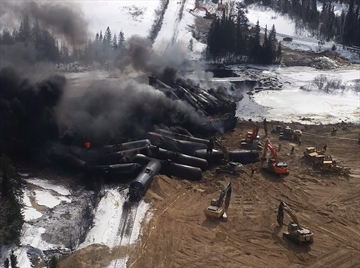Repost from insideHALTON.com
TSB points to track issues in derailments
By Paola Loriggio, The Canadian Press, March 17, 2015
Canada’s transportation investigator says track infrastructure failures may have played a role in three recent derailments involving oil-laden trains in northern Ontario.
The Transportation Safety Board says it wants Transport Canada to review the risk assessments for a stretch of track known as the CN Ruel subdivision following the fiery derailments in Gogama and Minnipuka.
It says trains have already been ordered to travel slowly on the Class 4 welded rail track due to “various infrastructure and track maintenance issues,” but that heavily loaded tank cars often exert “higher than usual forces” on the track.
The board says that exposes weaknesses in the track and makes it more susceptible to failure.
The agency says its preliminary observations on the March 7 Gogama derailment also found the tank cars performed similarly to those involved in the deadly derailment in Lac-Megantic, Que., despite meeting upgraded safety standards for Class 111 tank cars.
Similar observations were made about a Feb. 14 derailment near the same community, which is about 80 kilometres south of Timmins.
The derailments have fuelled the debate over transporting oil by rail and prompted the transportation ministers of Ontario and Quebec to express concern to their federal counterpart.
Last week, Ottawa proposed tough new standards for rail tank cars used to transport crude oil that would phase out the much-criticized Class 111 tank cars by 2025.
The proposal would require the new tank cars to have outer “jackets,” a layer of thermal protection, and thicker steel walls.
The Transportation Safety Board said Tuesday the proposed standards “look promising,” but must be implemented more quickly than suggested “given initial observations of the performance” of the upgraded Class 111 in recent derailments.
“If older tank cars, including the (upgraded cars), are not phased out sooner, then the regulator and industry need to take more steps to reduce the risk of derailments or consequences following a derailment carrying flammable liquids,” it said.



You must be logged in to post a comment.